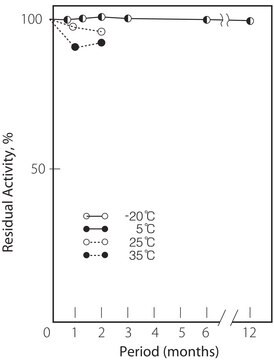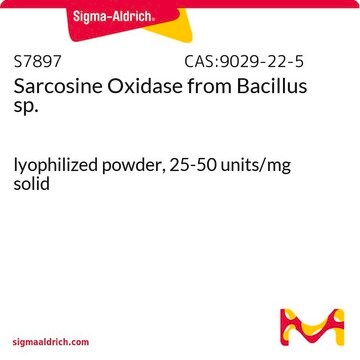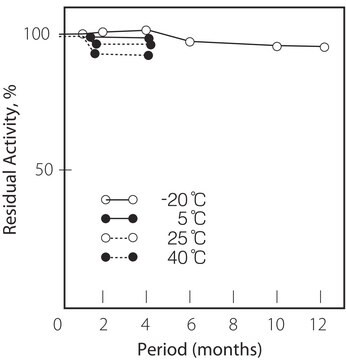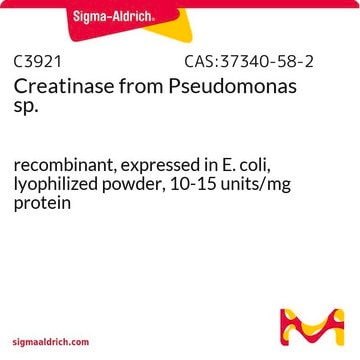C9409
Creatinine Deiminase microbial
lyophilized powder, ≥25 units/mg protein
Synonym(s):
Creatinine Deaminase
Sign Into View Organizational & Contract Pricing
All Photos(5)
About This Item
CAS Number:
EC Number:
MDL number:
UNSPSC Code:
12352204
NACRES:
NA.54
Recommended Products
form
lyophilized powder
Quality Level
specific activity
≥25 units/mg protein
mol wt
~260 kDa
composition
Protein, ≥15% biuret
storage temp.
−20°C
Application
Creatinine Deiminase microbial has been used:
- to immobilize aminosilylated glass beads based biosensor for ammonia/ammonium and creatinine detection in urine
- in creating creatinine-sensing membrane for biophysical studies
- to investigate the bioelectronic tongue for the simultaneous determination of urea, creatinine and alkaline ions in clinical samples
Creatinine deiminase has been used in a study to assess the application of a creatinine-sensitive biosensor for hemodialysis control. Creatinine deiminase has also been used in a study to investigate the bioelectronic tongue for the simultaneous determination of urea, creatinine and alkaline ions in clinical samples.
Biochem/physiol Actions
Creatinine deiminase catalyzes the hydrolysis of creatinine to methylhydantoine and ammonia.
Physical properties
Isoelectric point : 4.4
Michaelis constant : 3.5 x 10‾3M (Creatinine)
Structure : 6 subunits per mol of enzyme
Inhibitors : Ag+,Hg++, o-phenanthroline,monoiodoacetate
Optimum pH : 8.5 – 9.5
Optimum temperature : 65 – 75°C
pH Stability : pH 7.0 – 11.0 (30°C, 20hr)
Thermal stability : Below 65°C (pH 7.5, 1hr)
Michaelis constant : 3.5 x 10‾3M (Creatinine)
Structure : 6 subunits per mol of enzyme
Inhibitors : Ag+,Hg++, o-phenanthroline,monoiodoacetate
Optimum pH : 8.5 – 9.5
Optimum temperature : 65 – 75°C
pH Stability : pH 7.0 – 11.0 (30°C, 20hr)
Thermal stability : Below 65°C (pH 7.5, 1hr)
Unit Definition
One unit will hydrolyze 1.0 μmole of creatinine to N-methylhydantoin and NH3 per min at pH 7.5 at 37 °C in a coupled system with L-glutamic dehydrogenase.
Physical form
Lyophilized powder containing mannitol as stabilizer
Storage Class Code
11 - Combustible Solids
WGK
WGK 3
Flash Point(F)
Not applicable
Flash Point(C)
Not applicable
Personal Protective Equipment
dust mask type N95 (US), Eyeshields, Gloves
Certificates of Analysis (COA)
Search for Certificates of Analysis (COA) by entering the products Lot/Batch Number. Lot and Batch Numbers can be found on a product’s label following the words ‘Lot’ or ‘Batch’.
Already Own This Product?
Find documentation for the products that you have recently purchased in the Document Library.
[Immobilized enzyme reactors--their use in chemiluminescence detection].
M Tabata et al.
Tanpakushitsu kakusan koso. Protein, nucleic acid, enzyme, 31(3), 220-229 (1986-03-01)
A J Killard et al.
Trends in biotechnology, 18(10), 433-437 (2000-09-22)
Creatinine biosensors, based on both potentiometric and amperometric devices, have been created. However, there are significant problems still to be addressed, including the balance between sensitivity and selectivity, interference rejection and sensor stability. In addition, many devices still rely on
W F Stöcklein et al.
Biosensors & bioelectronics, 15(7-8), 377-382 (2001-02-24)
A procedure is described which allows the characterization of enzyme by a hybrid approach using an enzyme and an antibody. The presented method is related to the affinity determination of antibodies by the 'affinity in solution' procedure for BlAcore. The
Anjal C Sharma et al.
Journal of the American Chemical Society, 126(9), 2971-2977 (2004-03-05)
We developed a new sensing motif for the detection and quantification of creatinine, which is an important small molecule marker of renal dysfunction. This novel sensor motif is based on our intelligent polymerized crystalline colloidal array (IPCCA) materials, in which
O A Zinchenko et al.
Biosensors & bioelectronics, 35(1), 466-469 (2012-03-31)
The highly sensitive and selective potentiometric biosensor for creatinine determination has been developed by us earlier. In it, pH-sensitive field effect transistors were used as transducer and immobilized creatinine deiminase (EC 3.5.4.21)--as a biosensitive element. In the work presented, we
Our team of scientists has experience in all areas of research including Life Science, Material Science, Chemical Synthesis, Chromatography, Analytical and many others.
Contact Technical Service








